Axios
JS-NodeJS来自b站课程尚硅谷Web前端axios入门与源码解析
写在前面:此笔记来自b站课程尚硅谷Web前端axios入门与源码解析 / 资料下载 提取码:25lx
测试环境
使用json-server包:npm i -g json-server
创建db.json:
{
"posts": [
{ "id": "1", "title": "a title", "views": 100 },
{ "id": "2", "title": "another title", "views": 200 }
],
"comments": [
{ "id": "1", "text": "a comment about post 1", "postId": "1" },
{ "id": "2", "text": "another comment about post 1", "postId": "1" }
],
"profile": {
"name": "typicode"
}
}
启动服务:json-server --watch db.json
注:必须在db.json所在文件夹内的终端启动服务
基本使用
axios是一个基于promise的HTTP客户端,可以在浏览器和nodejs环境中运行
-
在浏览器端可以向服务端发送Ajax请求
-
在服务端可以发送HTTP请求
引入:
<script src="https://cdn.bootcdn.net/ajax/libs/axios/0.21.1/axios.min.js"></script>
发送Ajax请求
//通用方法axios
axios({
url: 'xxx',
method: 'POST', //请求方法(默认为GET)
params: {a: 100, b: 200}, //查询字符串
headers: {my_header: 'header'}, //请求头
data: {username: 'abc'}, //请求体
}).then(value => {
//value中存储着响应结果、状态等信息
});
//request方法
axios.request({}).then(value => {}) //使用方法同axios
//get方法--发送get请求
axios.get(url, { //第二个参数是配置项
params: {a: 100, b: 200}, //查询字符串
headers: {name: 'abc'}, //请求头
}).then(value => {
//value中存储着响应结果、状态等信息
});
//delete方法--发送delete请求
axios.delete({}).then(value => {}) //使用方法同get
//post方法--发送post请求
axios.post(url, { //第二个参数是请求体
username: 'abc',
password: 'xxx' //以json格式传递
}, { //第三个参数是配置项(同get)
params: {a: 100, b: 200}, //查询字符串
headers: {name: 'abc'}, //请求头
}).then(value => {
//value中存储着响应结果、状态等信息
});
//put方法--发送put请求
axios.put({}).then(value => {}) //使用方法同post
//patch方法--发送patch请求
axios.patch({}).then(value => {}) //使用方法同post
例:分别发送GET、POST、PUT、DELETE请求
<body>
<button>发送GET请求</button>
<button>发送POST请求</button>
<button>发送PUT请求</button>
<button>发送DELETE请求</button>
<script>
const btn = document.querySelectorAll("button");
btn[0].addEventListener("click", () => {
//获取第二篇post
axios({
method: 'GET',
url: "http://localhost:3000/posts/2",
}).then(res => {
console.log(res);
});
});
btn[1].addEventListener("click", () => {
//添加一篇post
axios({
method: 'POST',
url: "http://localhost:3000/posts",
data: {
title: "woshibiaoti",
views: 300
}
}).then(res => {
console.log(res);
});
});
btn[2].addEventListener("click", () => {
//更新第二篇post信息
axios({
method: 'PUT',
url: "http://localhost:3000/posts/2",
data: {
title: "another title",
views: 201
}
}).then(res => {
console.log(res);
});
});
btn[3].addEventListener("click", () => {
//删除第一篇post
axios({
method: 'DELETE',
url: "http://localhost:3000/posts/1",
}).then(res => {
console.log(res);
});
});
</script>
</body>
响应结果的结构
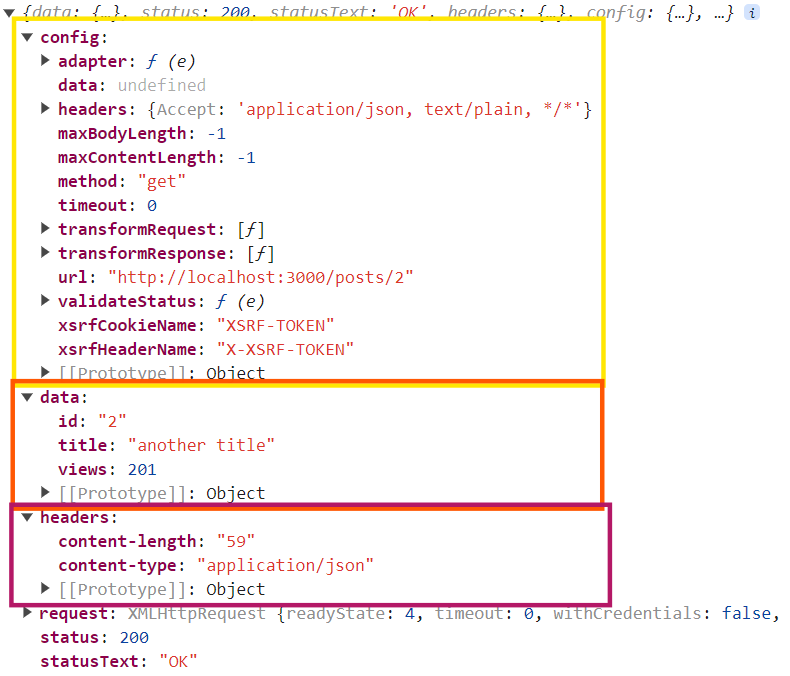
-
config:配置对象,包括请求url、请求类型、请求头、请求体等 -
data:响应体,是一个对象(或一个元素为对象的数组),axios自动对服务器响应内容解析,转成对象的形式 -
headers:响应头 -
request:原生的Ajax请求对象XMLHttpRequest -
status:响应状态码 -
statusText:响应状态字符串
配置对象的其它参数
-
baseurl:设定请求url的基础结构(协议和域名),这样url只写路径即可,在发送请求时axios会将其与url进行拼接比如在上例中,可以设置
baseurl: "http://localhost:3000/",这样url就可只写"/posts/2" -
transformRequest和transformResponse:分别对请求体数据和响应体数据进行处理transformResponse: [function (data) { //处理数据 return data; }] -
paramsSerializer(使用较少):对查询字符串进行格式转换,比如/post/a.100/b.200 -
data:请求体,如果是字符串就直接传递(如a=100&b=200,如果是对象就转成json字符串传递) -
timeout:超时时间,单位为ms,默认为0(没有超时限制),如果超过这个时间没有得到响应,就会返回reject的promise对象且取消请求 -
withCredentials请求时是否携带cookie,默认不携带 -
adapter发送Ajax请求还是HTTP请求 -
auth(使用较少)登录时设置用户名和密码 -
responseType设置响应体格式,默认是json,会自动转为对象 -
responseEncoding响应体编码格式,默认是utf-8 -
xsrfCookieName/xsrfHeaderName/withXSRFToken:cookie相关设置,分别是设置cookie名称/请求头名称/请求是否来自同一域名(起保护作用,避免跨站攻击,即为来自自己网页的请求加上特殊的唯一参数) -
onUploadProgress/onDownloadProgress上传/下载时的回调 -
maxContentLength/maxBodyLength:响应体/请求体的最大尺寸(单位为字节) -
validateStatus什么时候响应成功,默认响应状态码以2开头 -
maxRedirects向服务器发送请求时,最大跳转的次数(默认为5次),用在nodejs中 -
socketPathsocket文件位置 -
httpAgent/httpsAgent(使用较少):客户端设置 -
proxy:设置代理,常用于爬虫中切换IP -
cancelToken:取消请求设置 -
decompress:是否对请求结果解压,默认解压
默认配置
axios.defaults.配置项 = 值,设置后在axios函数中就可以不写,会自动按这个默认值来
-
axios.defaults.method请求类型 -
axios.defaults.baseurl请求的baseurl -
其实上面提到的所有配置项都可以设置默认值
axios.defaults.baseURL = "http://127.0.0.1:9000/";
axios.defaults.method = 'GET';
axios.defaults.timeout = 1000;
axios.defaults.params = { id: 100 };
btn[0].addEventListener("click", () => {
axios({
url: "/axios",
}).then(res => {
console.log(res);
});
});
创建实例对象
作用是可以设置多套默认配置
const axios_obj = axios.create({
//设置默认配置项(使用该对象发送的请求都会有这些默认配置项)
});
axios_obj({ //使用方式同axios函数
//其它配置项
}).then(value => {
//value中存储着响应结果、状态等信息
});
//还有get等方法,例如
axios_obj.get(url, {
//其它配置项
}).then(value => {
//value中存储着响应结果、状态等信息
});
例:
const axios1 = axios.create({
baseURL: "http://localhost:3000/",
timeout: 3000,
method: 'POST'
});
const axios2 = axios.create({
baseURL: 'http://127.0.0.1:9000',
timeout: 3000
});
btn[0].addEventListener("click", () => {
axios1({
url: "/posts",
data: {
title: "woshibiaoti",
views: 300
}
}).then(res => {
console.log(res);
});
});
btn[1].addEventListener("click", () => {
axios2.get("/axios").then(res => {
console.log(res);
});
});
拦截器
分为请求拦截器和响应拦截器
-
请求拦截器:对请求的参数和内容作处理和检测,如果有问题,就取消发送请求
-
响应拦截器:在得到响应结果前,先对响应结果进行预处理,例如响应失败时,可以作一些提醒和记录;还可以对响应结果进行一些格式化
//请求拦截器
axios.interceptors.request.use(config => {
//请求拦截器--成功
return config;
}, error => {
//请求拦截器--失败
return Promise.reject(error);
});
//响应拦截器
axios.interceptors.response.use(response => {
//响应拦截器--成功
return response;
}, error => {
//响应拦截器--失败
return Promise.reject(error);
});
//发送请求
axios({}).then(v => {
//得到响应
}).catch(r=>{
//得到失败响应
});
-
config:配置对象,这意味着我们可以在请求拦截器中对配置对象进行修改。例如config.params={a:100} -
response:axios的响应对象,不仅可以更改这个响应对象的内容,还可以通过修改return的值,来改变发送请求中v的值。例如return response.data,这样v就只有响应体内容,便于处理
如果在请求拦截器--成功中抛出异常/返回reject的promise对象,,则会继续依次执行响应拦截器--失败和得到失败响应中的代码
多个拦截器的情况:
axios.interceptors.request.use(); //第一个请求拦截器
axios.interceptors.request.use(); //第二个请求拦截器
axios.interceptors.response.use(); //第一个响应拦截器
axios.interceptors.response.use(); //第二个响应拦截器
实际执行的顺序是第二个请求拦截器->第一个请求拦截器->第一个响应拦截器->第二个响应拦截器
即请求拦截器先声明的后执行,响应拦截器先声明的先执行
取消请求
let cancel = null; //声明全局变量
axios({
cancelToken: new axios.CancelToken(c=>cancel=c) //在配置对象中设置取消请求的接口
});
cancel(); //调用函数即可取消请求
在取消请求后,会执行axios返回promise对象的失败回调
例1:点击一个按钮发送请求,点击另一个按钮取消
let cancel = null;
btns[0].addEventListener("click", () => {
axios({
method: 'GET',
url: 'http://127.0.0.1:9000/axios',
cancelToken: new axios.CancelToken(c => cancel = c)
}).then(v => {
console.log(v)
}).catch(r => {
console.log("取消请求成功");
});
});
btns[1].addEventListener("click", () => {
cancel();
});
例2:对发送请求进行防抖处理,即发送请求后,如果检测到之前已经发送过且还没得到响应,就取消前一次的发送
方法:将上面的cancel变量作为锁,得到响应后将其设为null
let cancel = null;
btns[0].addEventListener("click", () => {
cancel && cancel(); //如果cancel有值,说明还没得到响应,取消;没值就不取消
axios({
method: 'GET',
url: 'http://127.0.0.1:9000/axios',
cancelToken: new axios.CancelToken(c => cancel = c)
}).then(v => {
console.log(v)
cancel = null;
}).catch(r => {
console.log((new Date()).toLocaleTimeString() + "取消发送");
});
});
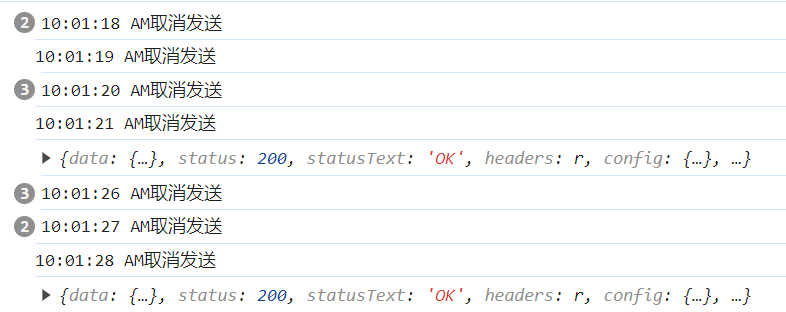
源码分析
目录结构
-
dist文件夹:打包后的最终输出的整体文件
-
axios.js/axios.min.js源码 -
mine-axios.js加了一些分析过程的源码
-
-
lib文件夹:核心代码
-
adapters文件夹:适配器,定义http和Ajax请求
-
http.js:nodejs发送请求 -
xhr.js:网页中Ajax发送请求
-
-
cancel文件夹:取消请求
-
core文件夹:核心功能
-
Axios.js:Axios构造函数 -
buildFullPath.js:构造完整url的函数 -
createError.js:创建error对象 -
dispatchRequest.js:发送请求(使用上面的适配器) -
enhanceError.js:更新错误对象 -
InterceptorManager.js:拦截器构造函数 -
mergeConfig.js:合并配置对象 -
settle.js:根据响应状态码改变promise对象状态 -
transformData.js:对请求和响应数据格式进行转换
-
-
helper文件夹:各种功能函数
-
axios.js:axios入口文件 -
defaults.js:默认配置 -
utils.js:各种工具函数
-
-
index.js:整个包的入口文件
axios的创建过程
<script src="../axios源码(中文注释)/dist/mine-axios.js"></script>
<script>
console.log(axios);
</script>
在浏览器中打开,f12->源代码
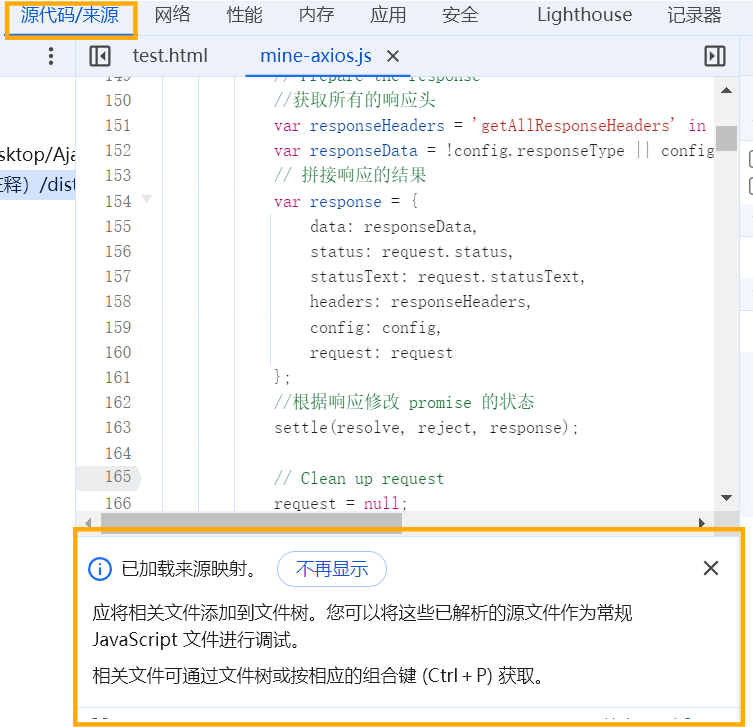
看到这行提示后,按ctrl+p找到入口文件axios.js,找到第38行,单击行号,设置断点
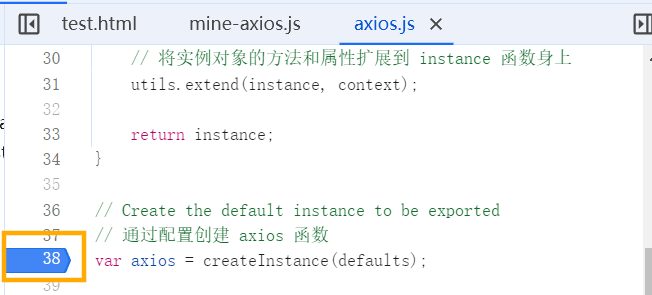
之后刷新页面
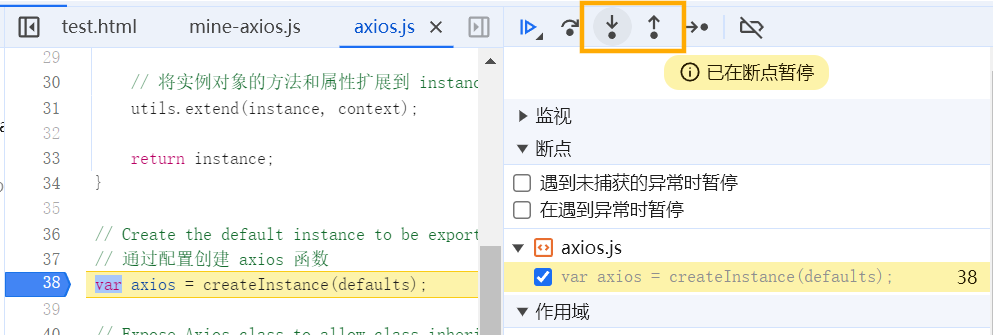
点击上下箭头即可查看上/下个函数调用
//1.通过默认配置创建axios函数(axios.js)
var axios = createInstance(defaults);
//2.创建一个实例对象context(axios.js)
var context = new Axios(defaultConfig);
//3.Axios构造函数(Axios.js)
function Axios(instanceConfig){
//给将Axios实例对象添加默认配置对象,拦截器对象
}
utils.forEach(['delete', 'get', 'head', 'options'], function forEachMethodNoData(method) { //给Axios原型添加各种发送请求的方法,这样Axios的原型对象就有了各种属性
Axios.prototype[method] = ...;
});
//4.将request方法的this指向context,并返回新函数instance(axios.js)
var instance = bind(Axios.prototype.request, context);
//5.将Axios.prototype和实例对象context的方法和属性都添加到instance函数身上(axios.js)
utils.extend(instance, Axios.prototype, context);
utils.extend(instance, context);
//总的来说,就是先创建一个函数,再给它添加属性
最终结果:instance(代码中的axios对象)既是一个函数,又是一个有很多属性的对象,所以我们可以写axios({}),也可以写axios.get({})
模拟实现axios的创建:
//Axios构造函数
function Axios(config) {
this.default = config; //创建default默认配置对象
this.intercepters = { //拦截器
request: {},
response: {}
};
}
//原型上添加各种请求方法
Axios.prototype.request = function (config) { //发送Ajax请求(是各种发送请求函数的公用方法)
console.log(`发送${config.method}请求`);
}
Axios.prototype.get = function (config) { //发送get请求
return this.request({ method: 'GET' });
}
Axios.prototype.post = function (config) { //发送post请求
return this.request({ method: 'POST' });
}
//Axios实例化
function create_instance(config) {
const context = new Axios(config); //实例化对象,此时它可以调用方法,但不能当成函数使用
const instance = Axios.prototype.request.bind(context); //instance是一个函数,它的this是context对象。此时instance不能调用方法
//将Axios原型对象的方法添加到instance上
Object.keys(Axios.prototype).forEach(key => { //遍历原型对象的方法(键名)
instance[key] = Axios.prototype[key].bind(context); //让this始终为context对象
});
//将实例对象的default和拦截器属性添加到instance上
Object.keys(context).forEach(key => { //遍历实例对象的属性(键名)
instance[key] = context[key];
});
return instance;
}
const axios = create_instance();
axios({ method: 'GET' }); //当成函数使用
axios.post(); //当成对象,调用方法

-
构造函数:默认配置项和拦截器
-
原型对象:发送请求的方法
-
实例化:
-
创建实例对象
-
将发送请求的公用方法
request绑定到instance上,this指向刚才创建的实例对象。此时instance只是函数 -
为
instance添加原型对象上其它发送请求的方法。此时instance也是对象 -
为
instance添加构造函数中的属性
-
-
返回创建的
instance(既是函数又是对象)
发送请求
因为axios就是上面的instance,是通过绑定request创建的,所以axios函数实际就是request函数
<script src="../axios源码(中文注释)/dist/mine-axios.js"></script>
<script>
axios({
method: 'GET',
url: 'http://localhost:3000/posts',
}).then(r => {
console.log(r);
});
</script>
f12->ctrl+p,在Axios.js的39行(request函数处)设置断点
//对传入的config配置对象进行处理
if (typeof config === 'string') {}
//将默认配置与传入的配置对象进行合并
config = mergeConfig(this.defaults, config);
//设定请求方法
if (config.method) {}
//创建拦截器中间件:第一个参数dispatchRequest用来发送请求,第二个为undefined用来补位
var chain = [dispatchRequest, undefined];
//创建一个成功的promise,其结果值合并后的请求配置
var promise = Promise.resolve(config);
//因为我们没用拦截器,所以这部分拦截器代码不会执行
while (chain.length) {
//依次取出 chain 的回调函数, 并执行
promise = promise.then(chain.shift(), chain.shift()); //因为promise是成功的,所以会执行第一个函数dispatchRequest
//dispatchRequest的返回结果会决定then的返回结果,即下一次循环中promise的值
}
//进入dispatchRequest.js
//如果被取消的请求被发送出去,就抛出错误
throwIfCancellationRequested(config);
//处理头信息、请求体、配置项等
config.headers = config.headers || {};
config.data = transformData()
config.headers = utils.merge()
utils.forEach()
//获取适配器对象
var adapter = config.adapter || defaults.adapter;
//调用adapter(config)发送请求,它也返回一个promise对象(具体值见下面的模拟实现)
return adapter(config).then(function onAdapterResolution(response) {
//成功的回调
throwIfCancellationRequested(config);
//对响应结果格式化
response.data = transformData(
response.data,
response.headers,
config.transformResponse
);
//因为response是一个对象,所以then返回一个成功的promise对象,结果值为response
return response;
}, function onAdapterRejection(reason) {});
//回到Axios.js
promise = promise.then(chain.shift(), chain.shift());
//chain.shift()返回一个成功的promise对象,因此promise也是成功的,结果值为上面的response
return promise; //axios({})函数的返回值
//回到调用axios函数处
axios({
method: 'GET',
url: 'http://localhost:3000/posts',
}) //是一个成功的promise对象,结果值为response
.then(r => { //获取response并输出
console.log(r);
});
总的来说,就是request方法调用dispatchRequest,其中调用adapter函数(xhr.js),最后将结果一层一层往外传递
模拟实现axios发送请求:
function Axios(config) { //构造函数
this.config = config;
}
Axios.prototype.request = function (config) { //发送请求
//略过处理config的部分,直接创建成功的promise对象
const promise = Promise.resolve(config);
//声明数组
const chains = [dispatch_request, undefined];
//遍历数组(为简化操作,这里直接调用promise的then方法执行dispatch_request)
const res = promise.then(chains[0], chains[1]);
//返回调用结果
return res;
}
function dispatch_request(config) { //dispatchRequest函数,返回promise对象,包括响应结果
//调用适配器
return xhr_adapter(config).then(response => {
//对响应的结果进行处理(这里就不作处理了)
return response;
}, error => {
throw error;
});
}
function xhr_adapter(config) { //adapter适配器,返回promise对象,包括响应结果
return new Promise((resolve, reject) => {
//发送Ajax请求(这里只考虑请求方法和url)
const xhr = new XMLHttpRequest();
xhr.open(config.method, config.url);
xhr.send();
xhr.onreadystatechange = function () {
if (xhr.readyState === 4) {
if (xhr.status >= 200 && xhr.status < 300) {
resolve({ //如果请求发送成功就resolve
config: config, //配置对象
data: xhr.response, //响应体
header: xhr.getAllResponseHeaders(), //响应头
request: xhr, //xhr请求对象
status: xhr.status, //响应状态码
statusText: xhr.statusText //响应状态字符串
});
} else { //失败就reject
reject(new Error(`请求失败,失败状态码为${xhr.status}`));
}
}
}
});
}
const axios = Axios.prototype.request.bind(null); //创建实例对象(为了方便就不进行绑定操作了)
//测试
axios({
method: 'GET',
url: 'http://localhost:3000/posts',
}).then(r => {
console.log(r);
});

-
适配器函数
xhr_adapter创建一个promise对象,在其中发送请求,过程类似于promise课程中“点击按钮发送Ajax请求”,都是请求成功就resolve(请求结果),失败就reject -
外层的
dispatchRequest函数接收这个promise对象,并为其指定then方法,将传入resolve中的请求结果取出,将这个结果作为一个成功promise的结果值,最后将这个promise对象传出 -
promise.then(chain.shift(), chain.shift())中执行chain.shift()(即dispatchRequest函数),它返回上面传出的成功promise对象,因此该语句也返回成功的promise对象,将其作为request函数的返回结果 -
最后,这个promise对象传给
axios函数调用处,调用then方法获取请求结果
补充:
const promise = Promise.resolve(config); //promise对象的结果值为config
const res = promise.then(dispatch_request, undefined);
该过程中,dispatch_request实际接收到了config,相当于
const res = promise.then(config=>{
dispatch_request(config);
}, undefined);
拦截器
<script>
axios.interceptors.request.use(config => { //设置拦截器
//请求拦截器--成功
return config;
}, error => {
//请求拦截器--失败
return Promise.reject(error);
});
axios({ //发送请求
method: 'GET',
url: 'http://localhost:3000/posts',
}).then(r => {
console.log(r);
});
</script>
在axios.interceptors.request.use处打断点
//设置拦截器
//Axios.js
function Axios(instanceConfig) {
this.interceptors = {
request: new InterceptorManager(), //调用的实际是InterceptorManager对象的use方法
response: new InterceptorManager()
};
}
//InterceptorManager.js
function InterceptorManager() {
this.handlers = []; //一个空数组
}
InterceptorManager.prototype.use = function use(fulfilled, rejected) {
this.handlers.push({ //将use里面传入的两个回调函数封装成一个对象,并压入handlers
fulfilled: fulfilled,
rejected: rejected
}); //每设置一个拦截器,就把回调放入handlers中
return this.handlers.length - 1;
};
//响应拦截器同理,它也有一个handlers
//发送请求
//Axios.js
var chain = [dispatchRequest, undefined];
var promise = Promise.resolve(config);
this.interceptors.request.forEach(function unshiftRequestInterceptors(interceptor) {
//这个forEach不是js的,是作者自己封装的,用于遍历其中的handlers属性
//将请求拦截器依次压入数组的最前面
chain.unshift(interceptor.fulfilled, interceptor.rejected); //先进后出
});
this.interceptors.response.forEach(function pushResponseInterceptors(interceptor) {
//将相应拦截器依次压入数组的最尾部
chain.push(interceptor.fulfilled, interceptor.rejected); //后进后出
});
while (chain.length) {
//依次取出 chain 的回调函数,并执行
promise = promise.then(chain.shift(), chain.shift()); //每次shift()都会改变chain的长度
}
return promise;
总结:设置拦截器的use函数其实只是把两个回调保存在了handlers里面,等到request函数调用时才真正绑定和执行
补充:
-
为什么添加拦截器时要一个unshift一个push?因为请求拦截要在dispatch之前执行,所以是在前面插入,响应拦截器在之后执行,在后面插入
-
promise.then(chain.shift(), chain.shift())详解:axios.interceptors.request.use(function one(config){}, function one(error){}); //第一个请求拦截器 axios.interceptors.request.use(function two(config){}, function two(error){}); //第二个请求拦截器 axios.interceptors.response.use(); //第一个响应拦截器 axios.interceptors.response.use(); //第二个响应拦截器forEach遍历之后chain的值:
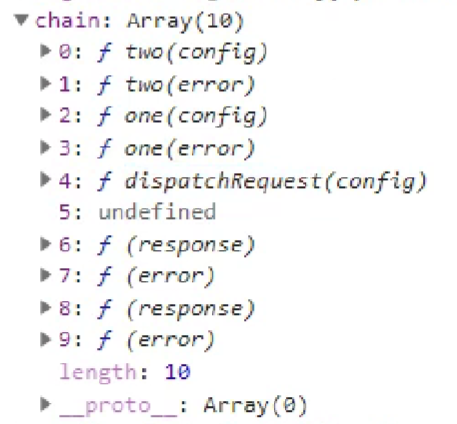
每两个元素为一对,是一个拦截器的成功和失败回调
这里需要说明的是:不管
promise是成功还是失败,then(chain.shift(), chain.shift())中两个shift函数都会执行,都会从chain中弹出两个元素,then只决定是否调用这两个回调因此,每次给promise添加的then方法为:
-
then(two(config), two(error)) -
then(one(config), one(error)) -
then(dispatchRequest, undefined) -
then((response), (error)) -
then((response), (error))
这样就可以实现:根据
promise的状态来执行拦截器的对应回调;因为promise的异常穿透特性,当遇到失败(执行error回调)时,会依次执行后面的失败回调。这也可以解释为什么初始化chain时需要undefined占位 -
模拟实现axios拦截器:
//创建Axios
function Axios(config) { //Axios构造函数
this.config = config;
this.interceptors = {
request: new interceptors_manager(),
response: new interceptors_manager()
}
}
Axios.prototype.request = function (config) { //request函数
let promise = Promise.resolve(config); //创建promise对象
const chains = [dispatch_request, undefined]; //创建chains数组
this.interceptors.request.handlers.forEach(item => { //将请求拦截器中函数压入chains中
chains.unshift(item.resolved, item.rejected);
});
this.interceptors.response.handlers.forEach(item => { //将响应拦截器中函数压入chains中
chains.push(item.resolved, item.rejected);
});
while (chains.length > 0) { //当chains里还有元素时
promise = promise.then(chains.shift(), chains.shift());
}
return promise;
}
function dispatch_request(config) { //这里就不写发送请求的代码了,直接返回请求结果
return new Promise((resolve, reject) => {
resolve({
status: 200,
statusText: "OK"
});
});
}
//创建实例,添加拦截器属性
const context = new Axios({});
const axios = Axios.prototype.request.bind(context); //axios函数,注意改request的this属性为实例对象,要不request中获取不到拦截器
Object.keys(context).forEach(key => {
axios[key] = context[key];
});
//创建拦截器
function interceptors_manager() { //拦截器管理器构造函数
this.handlers = [];
}
interceptors_manager.prototype.use = function (resolved, rejected) { //use方法
this.handlers.push({ //将传入的回调压入数组
resolved,
rejected
});
}
//测试
axios.interceptors.request.use(function one(config) {
console.log("第一个请求拦截器");
return config;
}, function one(error) { }); //第一个请求拦截器
axios.interceptors.request.use(function two(config) {
console.log("第二个请求拦截器");
return config;
}, function two(error) { }); //第二个请求拦截器
axios.interceptors.response.use(function (response) {
console.log("第一个响应拦截器");
return response;
}, function (response) { }); //第一个响应拦截器
axios.interceptors.response.use(function (response) {
console.log("第二个响应拦截器");
return response;
}, function (response) { }); //第二个响应拦截器
axios({}).then(r => {
console.log(r);
});
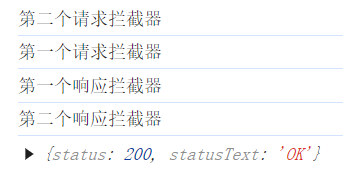
取消请求
let cancel = null;
axios({
cancelToken: new axios.CancelToken(c => cancel = c)
});
cancel();
执行过程:
//CancelToken.js
//创建cancelToken对象
function CancelToken(executor) { //构造函数
if (typeof executor !== 'function') { //执行器函数必须是一个函数
throw new TypeError('executor must be a function.');
}
var resolvePromise;
this.promise = new Promise(function promiseExecutor(resolve) { //在实例对象上添加promise属性
resolvePromise = resolve; //将修改promise对象成功状态的resolve函数暴露出去
//结果:resolvePromise()时就可将promise状态改为成功
});
var token = this; //token指向当前的实例对象
executor(function cancel(message) { //调用我们传入的执行器函数`c => cancel = c`,c就是这里传入的参数`function cancel(message){}`
//目的:将修改promise状态的函数暴露出去(赋值给外面的cancel
if (token.reason) return;
token.reason = new Cancel(message);
resolvePromise(token.reason); //让promise的状态变为成功
//结果:外面我们定义的cancel函数执行,则resolvePromise也执行,取消请求
});
}
//xhr.js
if (config.cancelToken) { //如果配置了cancelToken,则设置cancelToken.promise的成功回调
//因为promise必定是成功的,所以只指定成功回调就够了
config.cancelToken.promise.then(function onCanceled(cancel) {
if (!request) return;
request.abort(); //取消请求
reject(cancel);
request = null;
});
}
总结:最外面的cancer函数执行->function cancel(message) {}执行->resolvePromise执行->promise.resolve执行->状态变为成功->执行then的成功回调->回调中的request.abort()执行(这实际就是Ajax的abort方法),取消请求
因为abort函数是否要执行、什么时候执行都不确定,把它放在promise对象的成功回调中。如果想让它执行,只要改变promise对象的状态即可。然后将改变状态的函数暴露给最外层的cancer,让程序员自己决定什么时候调用
//创建Axios
function Axios(config) { //Axios构造函数
this.config = config;
}
Axios.prototype.request = function (config) { //request函数
return dispatch_request(config);
}
function dispatch_request(config) { //这里就不写发送请求的代码了,直接返回请求结果
return xhr_adapter(config);
}
//取消请求
function cancel_token(executor) { //CancelToken构造函数(对应源码中的CancelToken.js)
let resolve_promise; //声明变量
this.promise = new Promise((resolve) => { //给实例对象添加promise属性
resolve_promise = resolve; //将resolve暴露出去
});
executor(function () { //将修改promise状态的函数暴露给自己写的外层变量
resolve_promise();
});
}
function xhr_adapter(config) { //发送请求(对应源码中的xhr.js)
return new Promise((resolve, reject) => {
//发送Ajax请求
const xhr = new XMLHttpRequest();
xhr.open(config.method, config.url);
xhr.send();
xhr.onreadystatechange = function () {
if (xhr.readyState === 4) {
if (xhr.status >= 200 && xhr.status < 300) {
resolve({
status: xhr.status,
statusText: xhr.statusText
});
} else {
reject(new Error("请求失败"));
}
}
}
//给promise对象绑定then方法,取消请求
if (config.cancel_token) {
config.cancel_token.promise.then(v => {
xhr.abort();
reject(new Error("请求已被取消"));
});
}
});
}
//创建axios函数
const context = new Axios({});
const axios = Axios.prototype.request.bind(context);
<!-- 测试 -->
<button>发送请求</button>
<button>取消请求</button>
<script>
const btns = document.querySelectorAll("button");
let cancel = null;
btns[0].addEventListener("click", () => {
axios({
method: 'GET',
url: 'http://127.0.0.1:9000/axios',
cancel_token: new cancel_token(c => cancel = c)
}).then(v => {
console.log(v)
}).catch(r => {
console.log("取消请求成功");
});
});
btns[1].addEventListener("click", () => {
console.log("点击取消请求按钮");
cancel();
});
</script>
先成功发送一次,再取消发送一次:

总结
1. axios和Axios的关系:
-
从语法上来说,axios不是Axios的实例(axios是
Axios.prototype.request.bing()返回的函数) -
从功能上来说,axios是Axios的实例(axios是一个对象,且有Axios原型上所有的方法和属性)
2. instance和axios的异同:
instance是通过create方法创建的实例,axios也是,但它后续还添加了一些其它的方法
-
相同
-
都是一个能发任意请求的函数(
request(config)) -
都有发特定请求的方法(
get()post()…) -
都有构造函数中添加的属性(
defaultsinterceptors)
-
-
不同
-
默认配置可能不同
-
instance没有axios后续添加的方法(
create()CancelToken()all()…)
-
3. axios的整体运行流程
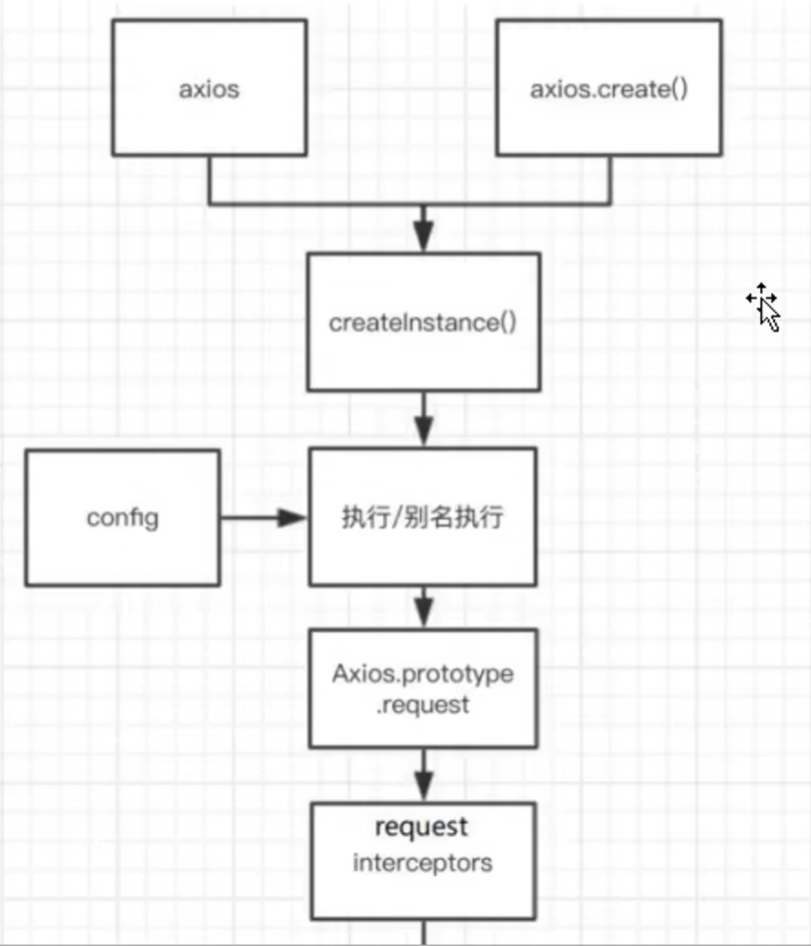
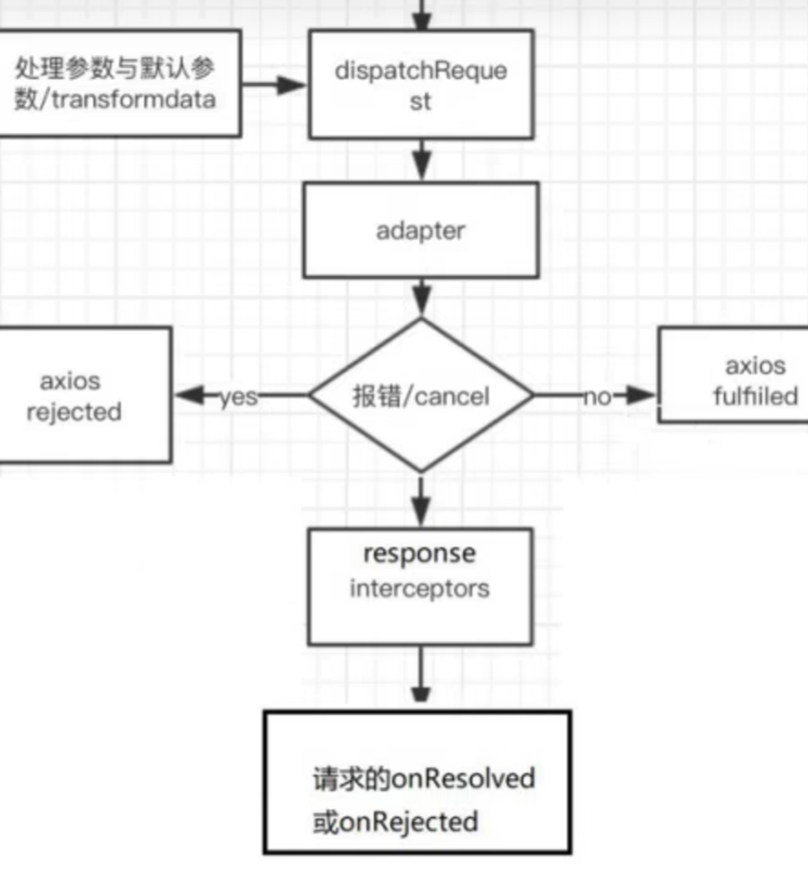
request(config)->dispatchRequest(config)->xhrAdapter(config)
-
request:将请求拦截器/dispatchRequest/响应拦截器通过promise链串起来,返回promise对象 -
dispatchRequest:转换请求数据->调用xhrAdapter发请求->转换响应结果,返回promise对象 -
xhrAdapter:创建XHR对象,根据config发送特定请求,接收响应数据,返回promise对象
4. 请求/响应拦截器:
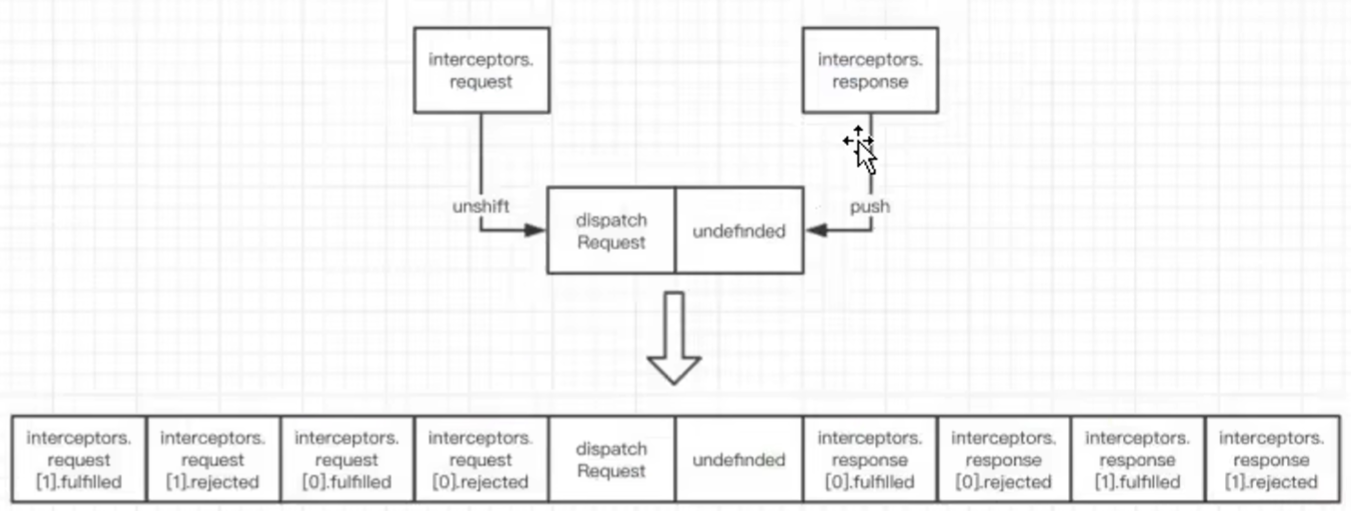
-
请求拦截器
-
在真正发送请求前执行,对请求进行检查,或对配置进行特定处理
-
成功回调传递的参数是
config配置对象,失败回调是error
-
-
响应拦截器
-
在请求得到响应后执行,对响应结果进行特定处理
-
成功回调传递的参数是
response响应结果,失败回调是error
-
5. 请求/响应数据转换器:
可以理解为有特定作用的拦截器
-
请求转换器:对请求头和请求体数据进行特定处理
if (utils.isObject(data)) { setContentTypeIfUnset(headers, 'application/json;charset=utf-8'); return JSON.stringify(data); } -
响应转换器:将响应体json字符串解析为js对象或数组
response.data = JSON.parse(response.data);
6. response的整体结构:
{
data,
status,
statusText,
headers,
config,
request
}
7. error的整体结构:
{
message,
response,
request
}
8. 如何取消未完成的请求:
-
当配置了
CancelToken对象时,保存cancel函数-
创建一个用于将来中断请求的
promise变量 -
定义了一个用于取消请求的
cancel函数(其中包含改变promise状态的代码) -
将
cancel函数传递出来
-
-
调用
cancel函数取消请求-
执行
cancel函数,传入错误信息message -
让
promise状态变为成功,值为一个Cancel对象 -
让
promise的成功回调中断请求,并让发送请求的promise对象失败,失败值为Cancel对象
-